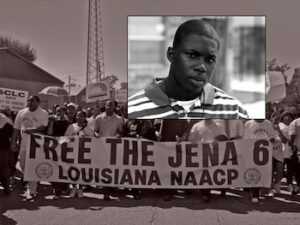
*The Jena Six are affirmed on this date in 2006. The Jena Six were six Black teenagers in Jena, Louisiana, convicted in the beating that year of Justin Barker, a white student at Jena High School, which they attended.
Jena High School is in the town of Jena, Louisiana, which has about 3,000 people. Some early reporting indicated that students of different races seldom sat together; Black students, when outside, typically sat on bleachers near the auditorium, while white students sat under a large tree in the center of the school courtyard. According to some of the school's teachers and administrators, students of all races had sat under it at one time or another.
At a school assembly held on August 31, 2006, a Black male freshman and his friends sat under the tree. The following morning, students and staff discovered rope nooses hanging from the tree. A Black teacher described seeing both white and black students "playing with [the nooses] that same day. Craig Franklin, assistant editor of The Jena Times, said the nooses hung were a prank by three students directed at white members of the school rodeo team. The school's investigating committee had concluded that "the three young teens had no knowledge that nooses symbolize the terrible legacy of the lynchings of Blacks in American history."
The names of those who hung the nooses were not publicly disclosed. Several episodes had taken place in and around Jena in the months before the Barker assault. These included the hanging of rope nooses from a tree in the high school courtyard, two violent confrontations between white and Black youths, and a fire in the main building of Jena High School. News coverage related to the Jena Six often reported these as linked. Federal and parish attorneys concluded from their investigations that the assessment was inaccurate.
On December 4, 2006, a group of Black students punched, kicked, and stomped Justin Barker. At first, the Blacks claimed that they beat Barker because he made a racist joke, but they advanced the explanation because they encountered three nooses. Superintendent Breithaupt described the battery as a "premeditated ambush and attack by six students against one.
The victim attacked was beaten and kicked into a state of bloody unconsciousness". Barker was released from a local emergency room after treatment and observation for a concussion and an eye that had swollen shut. The emergency physician's record shows that he also had injuries to his face, ears, and hand. While the case was pending, some media often cited it as an example of racial injustice in the United States, and the defendants had been charged initially with too-serious offenses and had been mistreated. Six students—Robert Bailey, then aged 17; Mychal Bell, then 16; Carwin Jones, then 18; Bryant Purvis, then 17; Jesse Ray Beard, then 14; and Theo Shaw, then 17—were arrested for the assault of Barker.
Mychal Bell was initially convicted as an adult of aggravated battery and conspiracy to commit aggravated battery. His convictions were overturned because he should have been tried as a juvenile. Before a retrial in juvenile court, Bell pleaded guilty to a reduced charge of simple battery. The other five defendants later pleaded "no contest" to the same offense and were convicted. The Jena Six case sparked protests by people who considered the arrests and charges excessive and racially discriminatory.
The protesters asserted that white Jena youths involved in similar incidents were treated more leniently. On September 20, 2007, 15,000 and 20,000 protesters marched on Jena. Related protests were held in other US cities on the same day. Added reactions included songs about the Jena Six, numerous editorials and opinion columns, and congressional hearings.